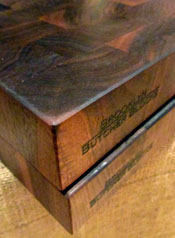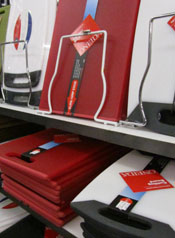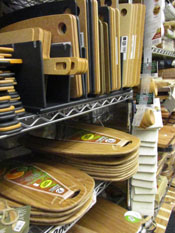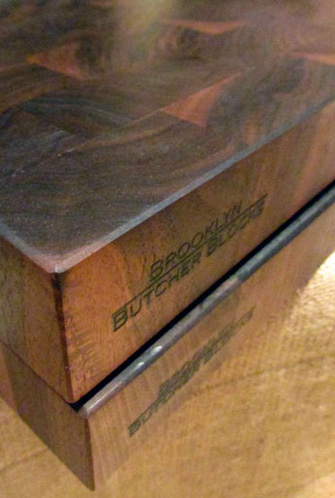Hardware & Software: Cutting Boards
For some reasons I've been asked a lot lately about cutting boards. Perhaps it has something to do with it being holiday time and we're handling things like raw turkey and keeping things pristine. Or we're second-guessing the state of our kitchens as we face making big meals. Or maybe we're just cooking more.
It is a good idea to occasionally do some equipment updating and cutting boards are on the short list of kitchen essentials, right alongside a chef's knife, wooden spoons, mixing bowls, and for me, a corkscrew. A board protects both the food being cut as well as your countertop, and it gives your knife a surface against which to work. And sometimes a board adds beauty to our work space.
A visit to any cookware store will show boards made of butcher block, plastics, and glass plus the more modern colorful silicones and bamboo, a renewable resource. Boards come in sizes that range from tiny to huge, and some with legs. So how to choose?
Choosing A Cutting Board
The first decision you need to make is what kind of material you want your cutting board made of and the choice isn't necessarily simple.
- Wood: This is, for many, the gold standard, although I think that's a bit of a limited point-of-view as many butchers and restaurants have long replaced their wood with plastic for sanitation reasons.
Wooden boards have many plusses: they are gentle on knives which means your knives stay sharp longer, they are natural, many can be re-sanded and thus refreshed when wear takes its toll, meaning good ones can last for many years, and they can be gorgeous. Wood boards come either as planks of wood, or carved into cute animals (pigs are popular), or like the surfaces of old fashioned butcher blocks. Butcher blocks are made either from the "end grain," meaning the ends of boards that have been glued together (these look a bit like a checkerboard) or "flat grain," with a stripe-like pattern, made from lengths boards. The point of gluing pieces of wood together is to create a surface that is stronger and more resistant to force (think of a butcher's meat cleaver) than a single plank. This is what makes them durable and also beautiful.
The cons? As wood is used it develops small cuts and crevices, which hold on to moisture, odors, and bacteria; the only way to remove these is to gently sand the surface or have this done professionally. And because wood is porous, it's not so simple to clean. It can't go in dishwashers, you can't soak them in water or they'll risk splitting, and even hot soapy water may not be enough to get a wood or butcher block board completely clean. Plus wood needs to be periodically oiled to keep from cracking or chipping. The oil should be a food-grade mineral oil sold in cookware stores; some advocate for using walnut or almond oils as these don't turn rancid as quickly as olive or vegetable oil but if anyone you know has a nut allergy, these are not options.
John Boos, a company in Illinois that has been making butcher block boards and countertops for professionals and home kitchens for more than 120 years, is the best known butcher block board brand.
With less a legacy but making superb craftsman quality is Nils Wessell of Brooklyn Butcher Blocks. Mr. Wessell makes boards from rough lumber shipped to him from Pennsylvania, primarily walnut and cherry, because, as he told me, "these woods are softer than maple and so let your knives keep their edge longer." He sands each board by hand and coats them with bees wax from local beekeepers. Any wood scraps left over are sent to Compost for Brooklyn in Kensington. Boards range in size from 12-by-14-inches and up, with 12-by-18 one of his more popular sizes. Mr. Wessell also does custom work. See the link below.
Many consider this type of board an investment (they can be costly) and also a treasure because with the right care, they can last a lifetime of cooking.
- Bamboo: This is one of the newer materials used for cutting boards. Made from one of nature's most renewable plants and harder and more durable than maple, bamboo boards have many of the plusses of wood. Moreover, some bamboo boards can be cleaned in the dishwasher. Being such a hard wood, it is my opinion that bamboo is not as gentle on knives as other woods or most plastics. Moreover, most bamboo boards cannot be sanded and rejuvenated in the same way as good butcher block. Then again, it's not as expensive and with such durability, may not need to be maintained as frequently.
- Plastic: Besides high density plastics, in this category I'm also including the new silicone boards that come in thicknesses from paper-thin to about one-inch. Restaurants, butcher shops and, as I learned, culinary schools, use boards made from either high density polyethylene or polypropylene which are opaque and white. Their surfaces usually have a subtle, slightly grainy texture, which helps prevent a knife from slipping.
Like wood, most plastic boards are gentle on knives, although some plastics are harder than others. In my judgment, the cheaper the board, the cheaper the plastic and the harder the surface. If in doubt, press the edge of your fingernail against the surface and feel for a very slight give -- not to be soft but not to be as hard as glass or laminate, either.
The big pro of plastic is cleaning and maintenance. You can put these in the dishwasher and also soak them in hot, soapy water to which you've added some bleach. Plain old Clorox. About 1/4 cup to a gallon of water is the mixture that restaurants use to clean professional kitchens. Some are made from antibacterial plastic that inhibits the growth of bacteria. And because you can completely clean it, plastic doesn’t take on the odors of foods as wood can.
Plastic and silicone boards also come in colors, which is appealing for anyone who wants to designate one board for meat and poultry and a different one for other foods. And as with wood, plastic boards sometimes come with a perimeter well to catch any liquids, a good thing when slicing juicy meats and poultry.
- Marble and Stone: Boards made from marble and granite are really only for rolling out pastry dough. That's because the board can be chilled which helps keep the dough cold when it's rolled. Never use a knife on a stone board because it can ruin the knife's edge.
- Glass: Glass cutting boards are murder on your knives. And as a knife's edge hits the slippery glass surface, it can slip and cause an accident. In my opinion, glass boards are only useful as a tray and for other serving and decorative purposes.
What's Best for You
There are several variables that will influence the kind of cutting board -- or boards -- that you should have. Primarily space, aesthetics, cost, cooking habits, and time.
- Space: Many of us have kitchens that are so small that there's no place to store a board when it's not in use. That means we leave our boards out either on a counter or propped up somewhere on its side. If you have tight quarters, get a board that serves multiple purposes, is easy to clean, and is great looking. For some this will mean butcher block, although wood has those maintenance issues I noted above.
If you have the room, get a large board because a generous surface makes it easier and safer to work. An alternative is to have a large board for major jobs and a small board for a quick slice of bread or mince of garlic.
- Aesthetics: This is a personal matter and translated to cutting boards, good looks mean different things. I have a friend who has an authentic butcher's cutting block; it weighs about 500 pounds and sits on its original wood legs. He keeps it in the center of his city kitchen and uses it not just for chopping but also serving snacks to his kids and hors d'oeuvres when friends are over for dinner. It's a thing of beauty, especially knowing it's had a long life and is still hard at work. But in my kitchen, I love my 15 x 20-inch white polyethylene board, the kind I was introduced to in culinary school and that I found in a restaurant supply store for $20. Others want color and will choose a silicone board in a vivid green or orange. It's personal.
- Cost: A durable and anti-bacterial polypropylene 12-by-16-inch board can cost about $20. A hand-crafted butcher block wood board in the same size can easily run $100+. But the wood is both for utility and beauty and with care, will last a lifetime.
- Cooking Habits: If you handle raw poultry and meat, it's important to have boards that are easy to clean and clean well. This would suggest plastic or silicone. If you work with highly aromatic ingredients, such as garlic or spices, you should have a board that doesn't absorb flavors or odors, again plastic being a better choice. If you cook for people with food allergies, you can buy plastic or silicone boards in different colors so to keep track of their dedicated uses.
- Time: This is the time you have to take care of your cutting boards. Having a wood board or butcher block means you need to regularly oil it to protect its surface; some say this should be done once a month. A good board should also be sanded periodically to remove the small surface cuts that develop from regular use. If this kind of maintenance is not for you and you prefer to just put you board into the dishwasher, you probably should have a plastic or bamboo board, not wood. But some of us love the chance to take care of a kitchen tool that has been made with craft and artistry. As with aesthetics, this is personal.
Other Tips For Using Cutting Boards
- Some who are concerned about sanitation and regularly cut poultry and meat dedicate a board to just those ingredients. But in my view, even if it's a chicken-only board, you still need to clean it completely between uses so that its surface doesn't contaminate anything that comes into contact with it. If you're really cramped for space, rigorous cleaning means you can get by with just one board.
- I keep a bottle of Clorox under my kitchen sink and add a capful to a bowl of soapy water and use this to wash down my cutting boards after most, but not all, uses. I'm more apt to do so if I've been working with poultry but if I've been making salads and cutting vegetables, or even slicing fish, I let hot soapy water, and a few swipes with a scrubby sponge be enough. So far no one has become sick in my kitchen.
- Some cooking experts advise using lemon and salt to clean a cutting board. It's an imperfect suggestion because while the lemon juice can help remove fat or grease, and the salt is a good abrasive, neither are detergents or sanitizers. Rubbing the cut end of a lemon against a salt-sprinkled board will refresh it, but it won't clean it.
- If your board moves around when working on it, place a damp paper towel between your board and your counter. The paper is thin enough so that you won't know it's there but the moisture is just enough to keep the board stuck to the countertop and thus, prevent slippage.
- Over time, plastic boards develop little cuts and crevices that become harder and harder to clean. Unlike wood, these little cuts can't be buffed away. When it seems like you can't wash away the little lines on the top of your cutting board, it's time to replace it.
- I've recently heard about disposable cutting boards that are made of plastic and can be discarded after a few uses. This makes no sense to me as it's an inferior cutting surface (how can it not be?) and adds to our landfills.
- In my kitchen I use a trio of white polyethylene and polypropylene plastic cutting boards: When I'm making a big meal or doing something more complicated, I will pull out my big 15 x 20-inch board that takes over a big part of my countertop. This board is too big to fit in my dishwasher and is also too large to lie flat in my sink. But it's a dream to work on because of its large surface. Most nights when I'm making a quick dinner I instead use my 10 x 16-inch board; this one is big enough to cut almost anything and it also fits in the dishwasher.
- For small jobs, or when I have something messy to cut I use an 8 x 10 board; sometimes I lay this on top of another cutting board, as when I'm mincing garlic, to keep the other board clean and then I slip the messed up small board right into the sink and return to working on the clean board underneath.
Above all, choose a board that helps you cook better and enjoy what you're doing. My friend's beautiful, vintage, restored butcher block makes him smile every time he chops parsley. Someone else I know keeps a multi-colored trio of boards for the "I'm keeping a safe-for-chicken kitchen" peace of mind when cooking for her kids. I love my huge plastic board for how my chef's knife feels against its surface, giving me more control.
Something as mundane as a cutting board can make your kitchen a happier place to be and it's one more small detail that helps you be a better cook.



